Last Updated on July 27, 2022
Engine oil is the lifeblood of your car’s engine. Without it, vehicles simply wouldn’t function. Motor oil protects your engine by lubricating parts which in turn minimizes heat and friction; the two biggest enemies of engine components.
As oil breaks down and becomes contaminated through normal use, it’s critical to follow the car manufacturer’s recommended oil change interval and replace the oil with the correct type. But what happens if you put the wrong oil in your car?
See Also: What Happens When You Drive Without an Oil Cap?
Engine Oil Service Classifications
In the United States, the American Petroleum Institute (API) sets standards for measuring the characteristics of passenger car engine oil. Over time, the oil required by vehicles has changed.
Cars from the 1920s, 1950s, 1970s, and so on require a different formulation of motor oil. Therefore, different engine oil classifications exist and will likely continue to be created in the future.
Gasoline Engines
The current service classification for today’s gasoline powered cars is “SN PLUS” which was introduced in 2018.
For new cars (2019 and newer – depending on when you read this), you want to make sure the motor oil you purchase has this classification noted in the “API Donut” image (see examples below) which is visible on all bottles of motor oil.
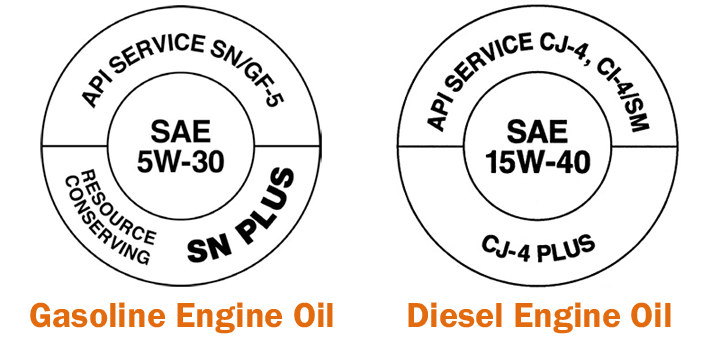
For older cars (2018 and older), you can also use motor oil with the “SN PLUS” classification but you may be able to also use older classifications depending on when your car was built. The table below notes these classifications.
| Category | Model Years | Status |
|---|---|---|
| SN PLUS | Use in gasoline engines of today's cars and older. | Current |
| SN | Use in gasoline engines for cars built in 2018 and older. | Current |
| SM | Use in gasoline engines for cars built in 2011 and older. | Current |
| SL | Use in gasoline engines for cars built in 2004 and older. | Current |
| SJ | Use in gasoline engines for cars built in 2001 and older. | Current |
| SH | Don't use in cars built after 1996. | Obsolete |
| SG | Don't use in cars built after 1993. | Obsolete |
| SF | Don't use in cars built after 1988. | Obsolete |
| SE | Don't use in cars built after 1979. | Obsolete |
| SD | Don't use in cars built after 1971. | Obsolete |
| SC | Don't use in cars built after 1967. | Obsolete |
| SB | Don't use in cars built after 1951. | Obsolete |
| SA | Don't use in cars built after 1930. | Obsolete |
Because of this, all the oil you buy in the present will have to be equal or better than the previous standards such as SG, SF, SJ, SL, and SM. Check your owner’s manual to find the right oil for your car and at least 2 accurate multi-grade specifications that coincide with the engine of your vehicle.
Do not just look for a brand name when choosing oil. Your manual should recommend an oil that has a requirement such as “compliant with standard SN of API.”
Diesel Engines
Vehicles powered by diesel engines have their own motor oil classifications. The types are a lot more confusing but the American Petroleum Institute does a good job explaining here. As long as you follow what your car or truck manual says, you’ll be fine.
Oil Viscosity
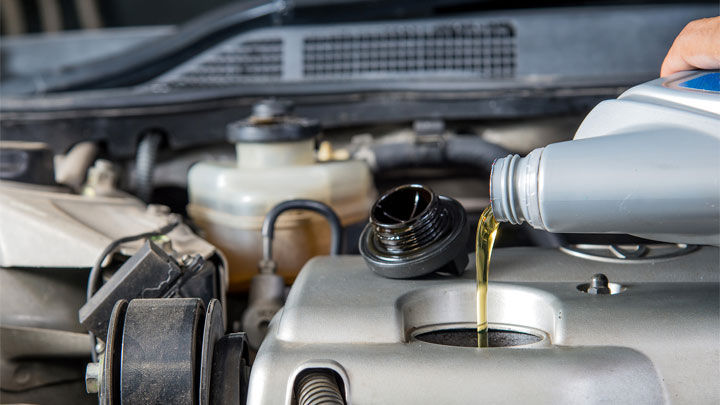
The motor oil in car engines has to function under various temperatures and pressures. For example, vehicles must endure cold weather during winter and hot weather during summer.
Oil has a harder time flowing in the cold and an easier time flowing in the summer. And if you’re towing a heavy load on top of that, it is even more work for the oil. This resistance to flow calculation is known as viscosity.
The numerical codes of these standards are defined by the Society of Automotive Engineers (SAE). Examples of engine oil viscosity include: 5W-20, 10W-30, and 20W-50.
Low Temperatures
The first number followed by the letter “W” in oil viscosity indicates how thick the oil is at low temperatures. The “W” stands for winter. The lower the number, the thinner the oil.
Since thinner oil flows better than thicker oil at low temperatures, running a 5W-20 oil would be much better in a Michigan winter than something like a 20W-50.
Related: Can Motor Oil Freeze?
High Temperatures
The second number in oil viscosity indicates how thick the oil is at normal operating temperature. The higher the number, the thicker the oil.
Thicker oil protects engine parts better than thinner oil under tough conditions. For instance, if you’re driving in Arizona in the middle of summer, a 20W-50 motor oil would protect your engine better than a 5w-20 viscosity.
Of course, you should always follow the manufacturer’s recommendation of what oil viscosity weight you should use in your vehicle. Too thin of an oil can result in not enough protection. Too thick of an oil can clog passageways (as is the case of DTC P0014).
Now that you should have a decent understanding about the basics of engine oil, here are some symptoms you may see if you accidentally put the wrong oil in your car.
See Also: Should You Check Oil When the Engine is Hot or Cold?
Wrong Oil in Car Symptoms
#1 – Hard to Start in Cold Weather

If the cold viscosity of your oil is too high (the oil is too thick), then you may not be able to start your car in very cold temperatures. In this case, the oil is too thick to properly lubricate all moving parts and this causes excess resistance during car starts.
#2 – Oil Leaks
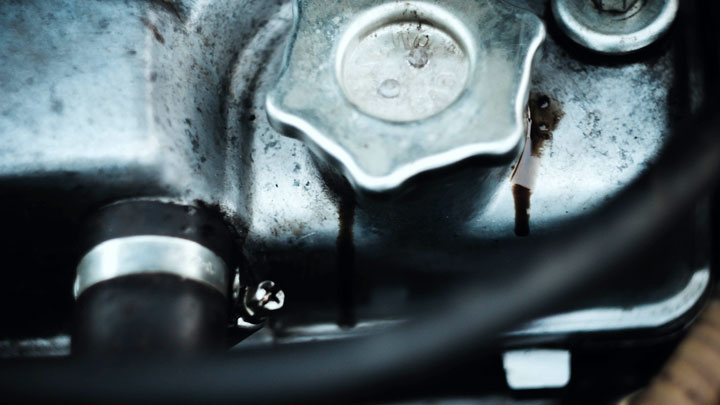
If you use a synthetic oil on an older or high mileage car, you may start to develop small oil leaks you would not get had you used a conventional motor oil.
This is simply due to the different flow characteristics that synthetic oils have which conventional oils don’t. It allows the oil to squeeze through tighter areas than regular oil.
While using a synthetic oil in these cases won’t necessarily cause any damage, you may notice drops of oil on your garage floor or a burning smell while driving. Because this oil is slowly leaking, you want to pay extra attention to your oil level and top off when needed.
Switching back to a conventional oil on your next oil change is recommended. Some vehicles simply don’t do well with synthetic oils.
#3 – Smell of Burning Oil
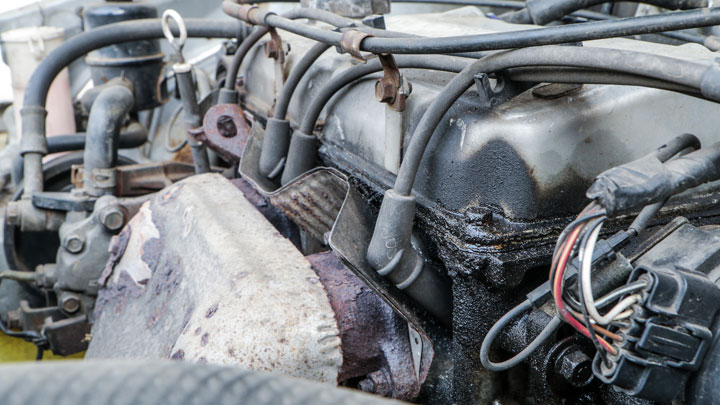
If the hot viscosity of the motor oil is not high enough, the oil may start to break down under extreme (hot) conditions and it won’t lubricate the components of the engine properly.
This will result in the oil being burnt. Over time, this can lead to long-term damage in your engine due to excess friction between metal components.
You may also experience the burning oil smell due to using synthetic oil and it leaking as mentioned above.
#4 – Poor Fuel Economy
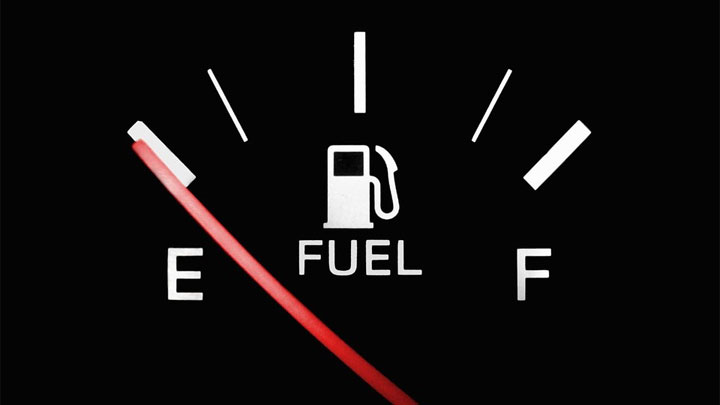
If you use too thick of a motor oil for the conditions, your fuel mileage will likely suffer. This is because the thicker oil increases resistance on moving parts such as pistons. While your engine will be protected, it will be at the expense of more frequent trips to the gas station.
Switching to a slightly thinner oil (example: 20w-50 to 10w-30) should help the situation.
#5 – Engine Ticking in Cold Weather
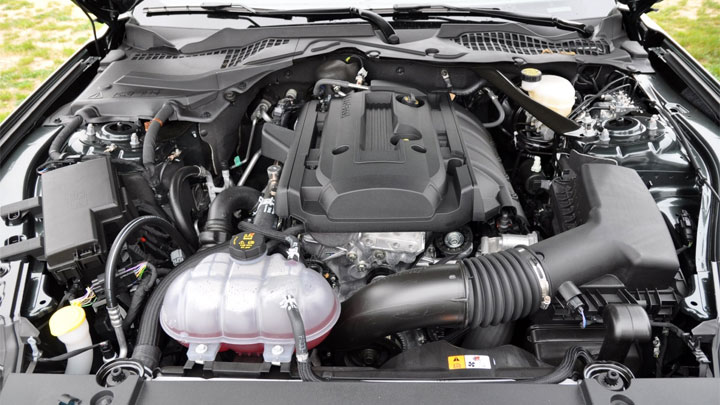
If you use too thin of a motor oil for the conditions, you may hear your engine making a ticking noise. This will usually be the loudest right after starting up and gradually decreasing after driving around for a bit.
This happens because the wrong weight of engine oil can do a poor job of coating and lubricating all engine components. What you are hearing is metal components such as valves and valve lifters hitting against other metal. Temporarily switching to a different oil viscosity may cure the problem.
Mixing Synthetic Oil with Conventional Motor Oil
If you accidentally add conventional motor oil to synthetic motor oil (or vice versa) to your engine, you have nothing to worry about.
The only reason why you wouldn’t want to do this is that synthetic motor oil is expensive and by mixing the two types, you’re simply not getting the benefits of the synthetic properties since the conventional oil is compromising those benefits.
At the next oil change, simply choose one type of oil over the other. Do not mix them.
Mixing Different Oil Weights
Should you worry if you accidentally add a thicker oil (ie: 20w-50) to a thinner oil (ie: 10w-30) that’s already in the engine? In most cases you’ll be fine.
Mixing the oil viscosities simply blends the two weights together. You simply don’t want to stray too far away from what oil viscosity the car manufacturer recommends to use. Using too thick of an oil can result in high oil pressure in some cases.
Mixing Different Oil Brands
While it’s not recommended to mix various brands (example: Valvoline, Castrol, Mobil 1, Amsoil, etc.) of oil, it won’t cause damage to your engine. What matters more is sticking with the same oil viscosity.
Since different motor oil brands have slightly different additives, you may be negating the benefits of one additive because you’re diluting it with a brand that doesn’t have that additive. It’s not a big deal but when you need your next oil change, stick to a single oil brand.
To Avoid Any Issues
If you’re still confused as to what oil type, viscosity, or weight you should be using, consult your owner’s manual. Your car manufacturer is by far the best resource for determining the best motor oil for your vehicle.
If you live in extremely hot or cold climates, you may need to use a slightly thicker or thinner oil but for the majority of owners, stick to what’s recommended.


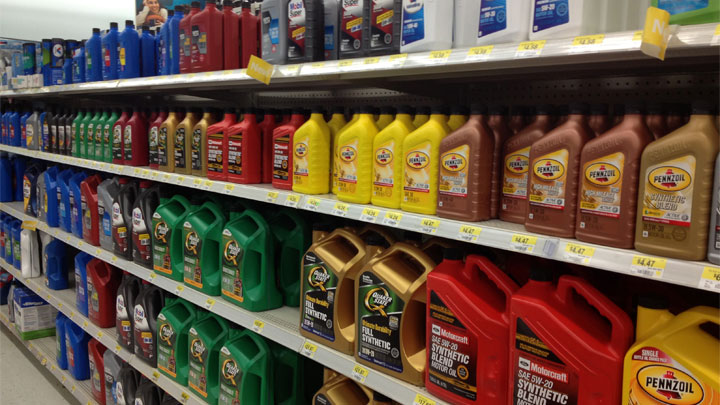
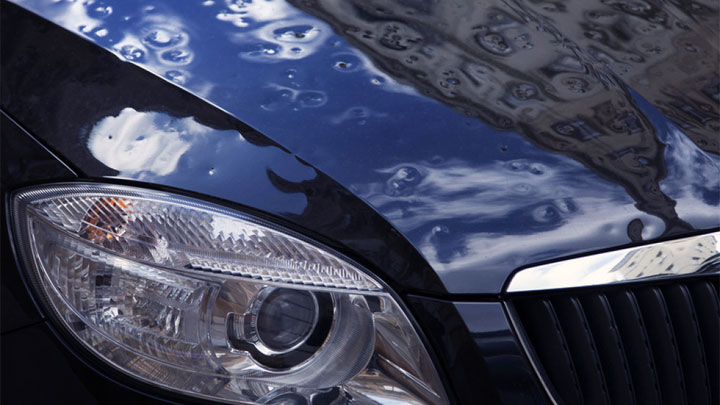

2000 Mitsubishi minter sport my camshaft position sensor failed now it seems like my engine seized it’s locked up.
That’s a computer issue (sensor) not an oil/mechanical issue. I replaced mine last year also and have to replace the power control module today.
I took my car to CarX and they put regular oil in my car. I know because of the price they gave me. I told them it was wrong because my car takes synthetic. They said they drained it but now my car smells like burning oil and it’s a mess under my hood. My remote start won’t work as my engine light is on now and my car sputters when I’m at a stop. Should I change my oil personally? I’m afraid maybe they didn’t actually drain it and put the synthetic as they told me.
Unless your car’s manual specifically states you MUST use synthetic oil, conventional oil is usually fine even if you were running synthetic previously. Usually only some high performance or turbocharged vehicles actually require synthetic since they operate at a higher temperature and synthetics take longer to break down.
All those symptoms sound like something else as a normal oil change wouldn’t cause that. Did the oil cap possible not get tightened on or did they put in too much oil? Both of these might cause excess oil in the engine bay which would burn and possibly cover some sensors.
Check your oil level and use a diagnostic scanner to see what triggered the check engine light.
I took a land rover defender diesel engine old model to a filling station and they put synthetic oil. After a distance. It smoked heavily from the exhaust. There were some oil leaks. The vehicle seemed to accelerate itself. Even when I switched it off, the engine was still running. There was heavy black smoke everywhere like the vehicle was almost burning. All the oil was completely finished that’s when it stopped.
When I put the right oil. It still stated but smoking heavly and no power to pull. Could my new turbo be destroyed?
I smelled something burning in my car. I pulled into a gas station and checked my oil. I added 2 quarts of oil that my car stayed. Went to pull off and my car was hesitating and then a big cloud of white smoke. I don’t understand. It it was running fine before I put the oil and I put the oil in the car started.
Some cars tend to smoke if overfill the oil;but probably yours it might be the rings or that table charger’s seals are gone
Hi! I changed my oil 01/10/20 and added Mobil1 “Annual protection” OW-20 in my 2010 nissan rogue, its been a couple of days now but nothing negative as yet, will this cause any damage? Thanks
Nissan recommends a 5W-30 for your Rogue but you should be fine even though the oil you put in is a bit thinner.
I have a 2006 Explorer 4.0 and took my car to the dealer for an oil change. When I got it back, the engine was ticking, and they said the timing chain is bad and I need a new engine! After review of my paperwork, I see that they overfilled the crankshaft by 3 quarts and used the wrong oil. 5W20 instead of 5W30. It appears they thought my truck was a V8 with the 4.6 engine. Did using the wrong oil, and too much of it cause my timing chain to stretch causing damage? Of course they won’t take responsibility.
That amount of difference 5W20 -> 5W30 will not make a huge difference. Take into consideration many cars allow you to run different weights depending on your climate conditions and/or oil availability. As an example my 2006 VW Jetta can take either 0W40 (colder climates) or 5W30 (warmer) engine oils. You might just get worse gas mileage.
Also, the difference between the 4.0 -> 4.6 ford is 1 quart NOT 3 (not to mention you don’t fill up your crankshaft with oil but instead your oil pan but I know what you meant hehe). Running a quart too much isn’t going to cause immediate catastrophic damage, you’d likely see blue smoke since you’d be feeding excess oil past your pistons and your PCV system. I’d also bet you’d noticeably see oil coming out of the dipstick tube and all over your engine which would have been quite difficult to clean up.
Given that the car is 14 years old it’s it was probably well overdue for a timing chain (or likely tensioner) service.
My Optima hybrid is hesitating at highway speeds and is challenged with losing some power on upgrades when the hesitation randomly occurs. After the hesitation, the oil light comes on very briefly then goes off and the engine runs normal again. Oil is full and fairly recently changed. Wrong oil?
The oil light usually means you have low oil pressure. I would have the oil pump tested to make sure it isn’t on its way out.
I’m in Nigeria, Africa. I use 20W-50 for my car but the recommended one is 5W-30 engine oil. My exhaust emit white smoke. What’s wrong please ?
It’s generally recommended to stick with the manufacturer’s recommended oil viscosity, unless you have a very good reason for switching (such as extreme temperatures or operating conditions). There is a big difference between 20W-50 and 5W-30. It’s hard to say what the root cause of the white smoke is without a bit of testing.
white smoke = bad head gasket or cracked head gasket allowing water into the cylinders.
Blue / black smoke = oil in cylinders
Blue also could be lean fuel or bad spark not burning fuel
Black smoke is burning oil.
White smoke is steaming water vaper
Bought a 2009 Audi A3 1.9 tdi 173000 miles
Was low on oil when bought so topped up with a regular 5/30 full synthetic now getting loads off white ish smoke but does clear when on motorway but when been sat about smokes really badly should I get service or any ideas thsnks
I’d do a compression and leak down test so you can get a better idea of what’s going on with the car. When you buy a used car, you often don’t know what you’re getting into until the car is inspected closely.
Great article to read! Now I learned next time I will check and remember all possible symptoms in case there will be a problem with my car.
I’m in Nigeria, Africa and I recently changed my car (Lexus RX350, 2007) engine oil with 6 Litres of Mobil 1 5W30 fully synthetic. Two days after the oil change, I noticed my check engine light was flashing. The car was taken to an auto-workshop immediately where the oil check was found to be extremely low, water was seen gushing out from the exhaust pipe and the car was difficult to start. The auto engineer concluded that the top cylinder gasket was burnt and some of the valves were bad after further check.
The mileage on the car was 180,420; no evidence of oil leakage and the vehicle was not smoky prior to the incident. The top cylinder gasket and all the 24 valves were replaced.
Oando oleum SL 20W50 was suggested for a further oil change by the auto repairer.
Is the suggestion a wise one or not?
I personally do not use oil that heavy in any of my vehicles, and would not recommend it on a vehicle that has 5W30 specified from the factory.
What would happen if Castrol 5W-30 A5 was put into my Mercedes GLE 350D by mistake instead of Castrol 5W-30 C3.
The reason is my engine has seized after service July and after 4000miles
You would have to double check the owner’s manual to confirm this, but I think A5 would still have all the necessary certifications for your vehicle. I really don’t think this oil would cause your engine to seize.
The oil put into my car was Castrol 5w-30 A5 oil
I contacted castrol they told me this oil is not allowed for my car.
The Car manual states on use oil that use MB229.31 MB229.51 MB229.52
Good you checked with Castrol, however I would still be surprised if this oil caused your engine to seize. Please let me know what you find out if you could.
I use a Toyota Camry 2008, I had the oil seal between the engine and gearbox change and had my engine oil changed from Total 20W-50 to HPS 20W-50, my car would start and not accelerate at full capacity when on motion. I have changed the fuel pump, plugs, coil yet no improvement. Took the car for scan and P0166 code was detected. i.e Crankshaft Position Camshaft Position Correlation Bank 1 Sensor ‘A’. All the sensor was checked and working properly. The timming chain was checked and it’s ok. 271230 mileage. Excess fuel consumption and heavy tapping sound when you turn on the engine that stop after awhile
Yet the acceleration on motion is too slow. Is it the change of oil that is causing it?
I think it’s very unlikely that an oil change caused that issue. Are you sure that’s the right code? I think P0166 is for an O2 sensor.